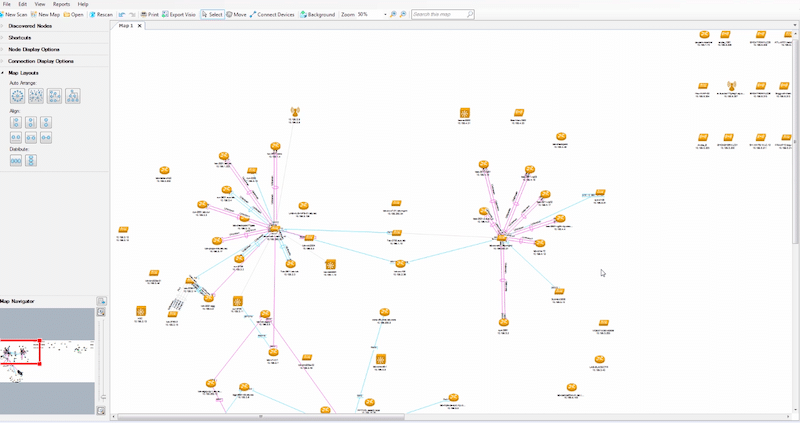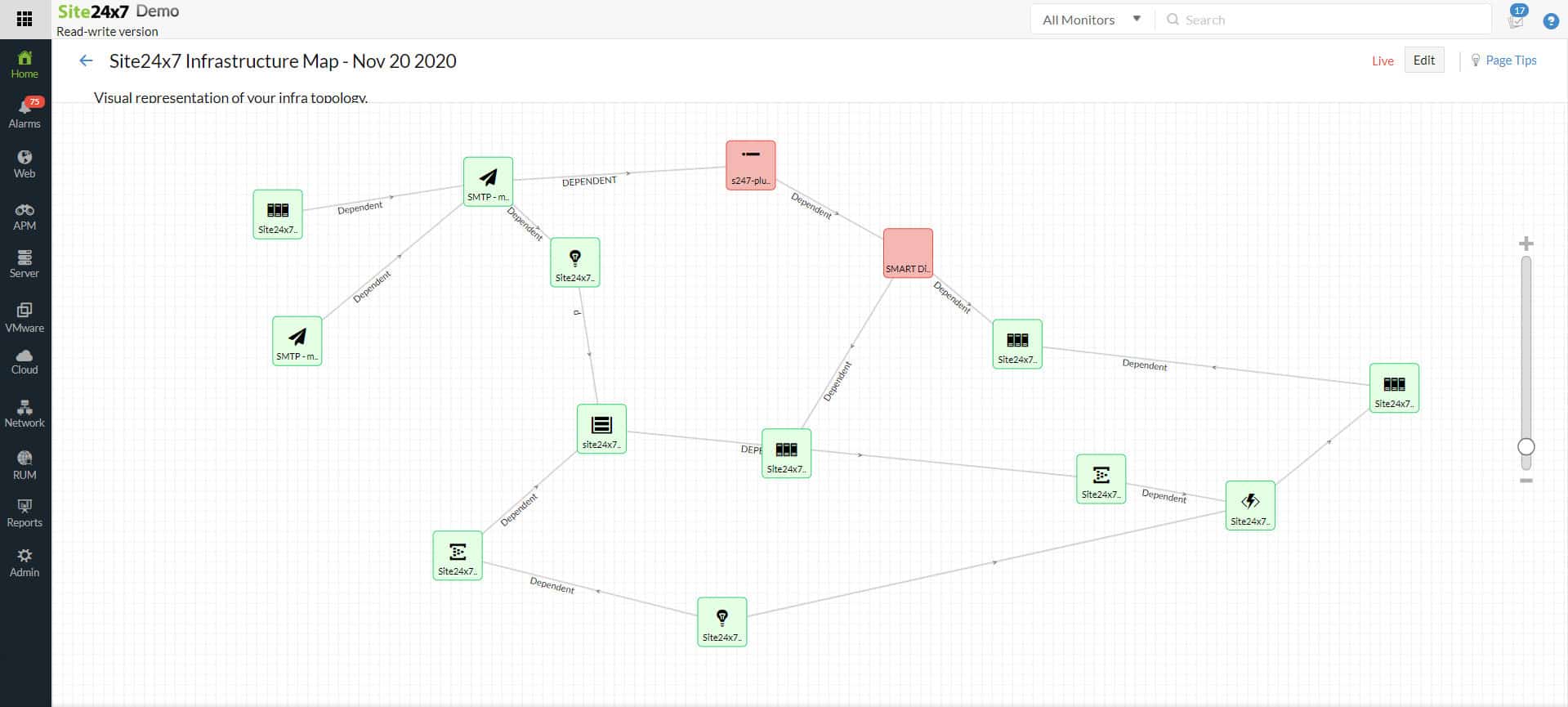We may earn a commission if you make a purchase through the links on our website.
Network Topology Guide: Types, Mapping, and Design
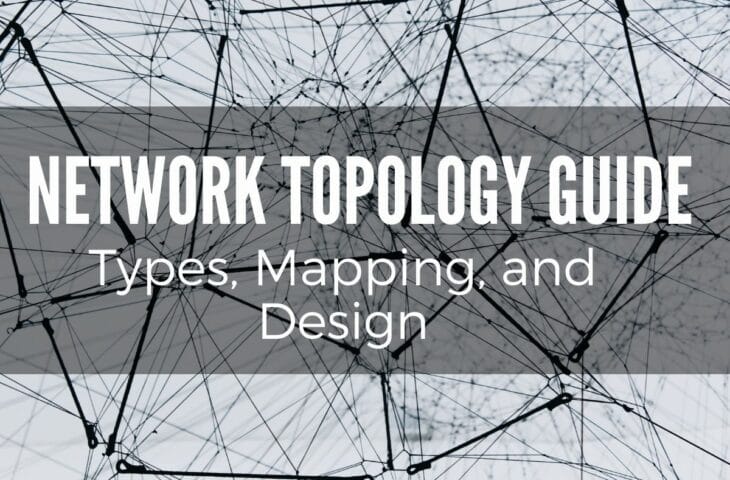
UPDATED: January 10, 2024
A network topology is so essential for various reasons. First, it is key to how well your network works. The right network topology can improve the performance, reliability, and security of your network.
In this post, you’ll learn what a network topology is, how it is connected, classified, and types. Then, in the last section, we’ll introduce how to design and map them using the software.
Table of Contents
- What Is Network Topology?
- Connection types.
- Classifying network topologies.
- What are the types of Network Topology?
- Linear “Daisy Chain” Topology.
- Ring Topology
- Bus Topology
- Mesh Topology
- Hybrid Topology
- Tree Topology
- Network Topology Design and Mapping.
- Determining the right fit.
- How to map your network topology?
- Final words.
What is Network Topology
Network topology refers to the logical or physical layout of a network. It maps the way nodes are placed and interconnected and also deals with the flow of data. The types of network nodes are clients or servers and links wired lines or wireless. And the flow refers to the direction of traffic; it is unidirectional or bidirectional.
The network topology clients can be workstations or computers, while servers can be infrastructure or networking nodes like hubs, switches, or routers. Ideally, clients would not need to forward data packets to other clients, but some network topologies that work without servers would have them do so.
Logical topology vs. physical topology?
The logical network topology deals with the protocols that control the “logical paths” on the network. While a logical topology depicts how devices “appear” connected, the physical topology is “actually how” devices are physically interconnected. Networks have both a physical and logical topology, but they don’t necessarily need to be the same. For instance, the popular LAN type, Ethernet, uses a logical bus topology in either a physical bus or star.
Connection types
While network topology looks at the entire picture, a connection type defines how two-three elements are interconnected. Thus, network topologies are built either with point-to-point, point-to-multipoint, or multi-drop connections.

- Point-to-point connections are the simplest form of connection models. This type of communication is simply a dedicated link between two nodes, where all bandwidth is fully utilized between these two nodes. Point-to-points can be compared to a simple transit system, where each point has a specific and direct route to every other point (and not more than one). In point-to-point, there is one transmitter and one receiver. The connection can happen in a half-duplex or full-duplex mode. This connection can be physical, as two computers connected via a rollover cable, or logical as a client and server connected over a VPN tunnel.
- Point-to-multipoint. In a point-to-multipoint connection model, the link (or channel) is shared among other nodes. Here, there is one transmitter and many receivers. Examples are the star topology, either wired or wireless.
- Multi-drop connections. This type of communication follows a single line that drops connections to every single node along the way. Thus, multi-drop is not point-to-points and multi-points connected, but points connected to a single line. A popular example is bus topology.
Classifying network topologies
Network topologies can be classified by how their elements are interconnected. Depending on the type of nodes and links, topologies can vary from centralized, decentralized to distributed.

These qualities are relevant in networking because they can make or break the design. For instance, star, bus, or tree topologies use centralized systems (one server and many clients). Mesh, ring, and hybrid use decentralized (many servers to many clients) and distributed (the full mesh).
Below is a table describing a few differences between centralized, decentralized, and distributed.
| Quality | Centralized | Decentralized | Distributed |
| Points-of-failure | Single | Finite | Infinite |
| Maintenance | Simple | Moderate | Complex |
| Scalability | Low | Moderate | Infinite |
| Reliability | Unreliable | Moderate | Reliable |
| Deployment | Easy | Moderate | Complex |
Network Topology Types.
Different connection types and classes form the network topology. There are seven popular network topology types.
1. Linear Daisy Chain Topology
The daisy-chain topology gets the name from the similarity of daisy flower chains. In electrical, electronic engineering, or computer networking, a linear daisy chain interconnects multiple devices point-to-point (one by one) in a sequence or series fashion.
In a daisy chain linear topology, the devices are connected via a two-way link. All the clients need two network ports, one for input (receiving) and another for output (transmission), except at each end. In this type of topology, the flow of data is unidirectional. If a computer in the middle expects a message, the package must travel across the entire chain until it reaches its destination.
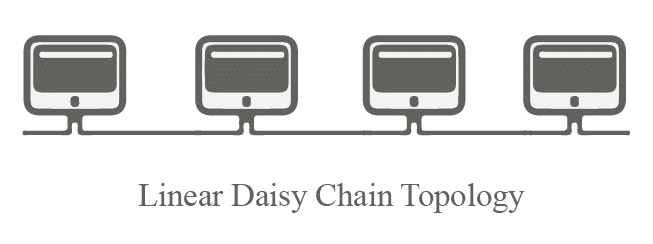
Pros and Cons?
- Pros. The main advantage of a daisy chain is its simplicity and cost-efficiency. In addition, there is no need for intervening devices (switches or hubs). Instead, the devices themselves form the backbone.
- Cons. Daisy chains have poor scalability. If the network grows, it can become slow. Linear daisy chains also have inadequate redundancy. If a cable or computer breaks, many computers will be offline.
2. Ring Topology
In the ring topology, all the nodes connect to exactly two other nodes. So every node along the ring would need to handle traffic traveling across. These two nodes can be combined or via a switch. Ring topology is commonly used in the Metropolitan Area Network (MAN).
Ring topologies are known to have unidirectional traffic, although some implementations would also allow bidirectional traffic. Unidirectional flows reduce the chances of packet collisions, but they also introduce the single-point-of-failure. Unidirectional ring topology may use a Counter-rotating ring (C-Ring) to keep a certain degree of redundancy while avoiding collisions. If the loop breaks, the transmission can still happen by using the C-ring. If nodes have two connections between each node, the topology may use bidirectional traffic. This is known as the Dual Ring topology. The latter provides higher redundancy. In case of failure, the network stays online by changing the flow direction away (reverse) from the error (it reverts to linear).
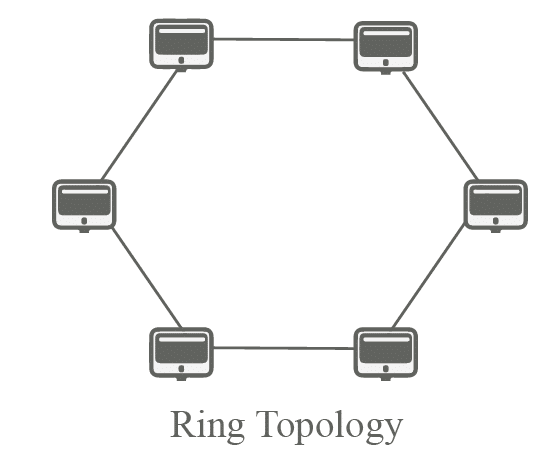
Pros and Cons?
- Pros. The number of transmitters and receivers is reduced by half (as compared to linear topology). Unidirectional flows also help reduce packet collisions.
- Cons. Each computer in the ring must process each packet that goes through, making scalability a disadvantage. Plus, if one node fails or the cable breaks, the entire network might be down.
Token Ring vs. Ring Topology?
Token Ring is a logical ring topology but physically wired as a star. It is highly organized because it passes tokens along so that every device gets the chance to transmit. On the other hand, ring topology is the physical topology.
3. Bus Topology
Bus topology is also referred to as line topology (or backbone topology). It can be either linear or distributed. A bus network topology uses a single line of cable running from end to end. All devices on the network are connected directly to this single line (or bus), which is commonly a half-duplex link coaxial cable. In a bus topology, every host (or station) receives all traffic and has the same priority for transmission.
Bus topologies are used in LANs, where the different nodes are linked to the one line or single backbone, so they must use CSMA or bus master to avoid collisions. This topology forms a single network segment and collision domain. To build it, you must use cable joints and terminals.
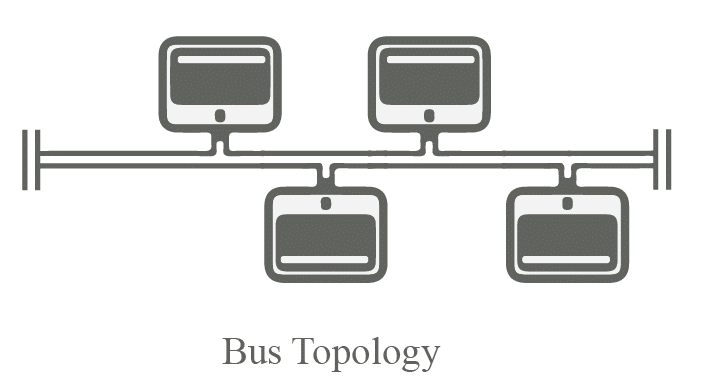
Pros and Cons?
- Pros. The topology is cost-efficient. A limited amount of cable is needed to connect computers. Plus, it is simple to add a new node. There is no need to use a switch or hub. Just split the bus (central cable) and add an interface connector.
- Cons. The single line is a single point of failure. If the cable breaks, the entire network goes offline. Plus, if there is an error along the line, it can be challenging to spot it. Bus topologies are not suitable for networks with scaling traffic due to growing maintenance and poor security.
4. Star Topolog
The star topology was influenced by the Spoke-and-Hub distribution model— a form of transport topology optimization. It started when traffic planners from passenger transportation and freight started to organize their routes as arrays of spokes connecting to a central hub. Soon, the efficient idea hit the IT sector, where they renamed it the “star network topology.”
This topology uses a single point-to-multipoint connection, and it is often used in WAN connections. In a WAN star topology, the hub (the main office) centralizes multiple geographically distant spokes or peripheral nodes (branch offices). All spokes are interconnected via the hub and never to each other. So, when a spoke needs to communicate with another, they will inevitably have to go through the hub. The star topology can be extended (where spokes use extension repeaters) or distributed star (daisy-chained ring-based individual networks).
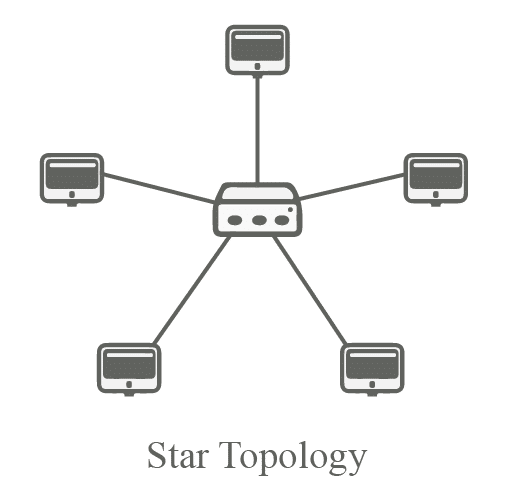
Pros and Cons?
- Pros. The centralization allows better management and monitoring. Plus, adding (removing or replacing) a node is as easy as just connecting (or removing) it to (or from) the switch. Another advantage is its reliability. If a cable breaks, only one computer goes offline.
- Cons. The central (hub) can be a point of failure and traffic bottleneck. In addition, if the switch has poor performance or breaks, all the network is affected.
5. Mesh Topology
The mesh topology can be either a fully or partially connected mesh network. In the entire mesh topology, all networking devices are directly interconnected in a non-hierarchical architecture. In the partial mesh topology, some devices are connected to many devices, while others are connected to only one or two. All these interconnected server devices work together to efficiently route data to and from distributed clients.
What stands out from the mesh topology is its reliability and redundancy. There is no central node or dependency on a single node that would act as a single-point-of-failure. Instead, every server node in the mesh participates in the information relay.
An example of a full mesh topology is the Leaf and Spine network architecture, a common topology in data centers.
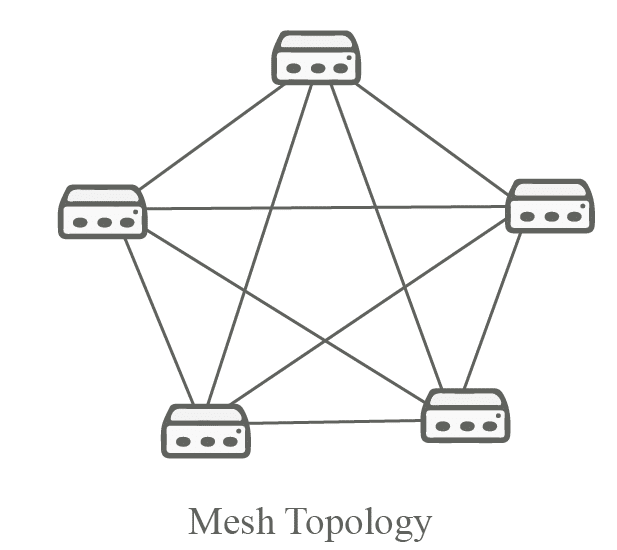
Pros and Cons?
- Pros. High fault tolerance, redundancy, and reliability. If well configured, mesh topologies would result in dynamic networks that can organize, heal, and balance themselves. If a single (or few) nodes fail, the mesh network can distribute traffic dynamically. This characteristic reduces maintenance costs.
- Cons. Although maintenance cost is low, the implementation can be difficult and costly. Cabling a full mesh topology can be a difficult and expensive job, especially when networks scale.
6. Hybrid Topology
Modern networks are rarely designed using a single type of topology. Instead, designers leverage the advantages from each topology and combine them. For example, hybrid topologies are made by combining two or more topologies such as bus, star, ring, or linear.
Examples of hybrid topologies are:
- Star-Bus or Tree Topology: (explained in the next section).
- Star-Ring: Clients are connected to the server as a star, while servers are interconnected using a ring network.
- Star-Star (Snowflake): Although not a combination of two different topologies, the snowflake network connects main servers with secondary, using stars, and secondary servers with clients using a star.
- Hierarchical-Star or Physical extended star. Similar to the above, but defined as using extension repeaters (as secondary servers).
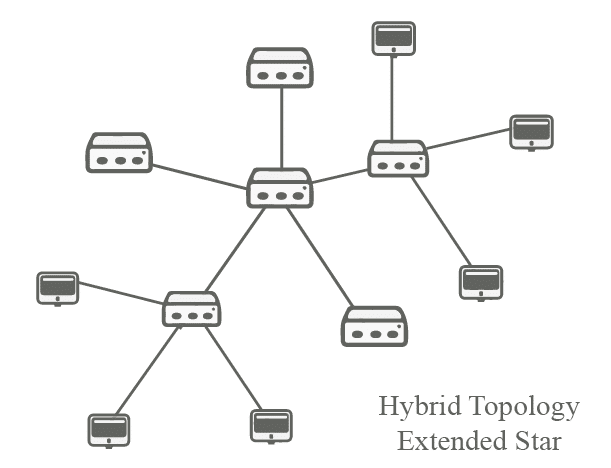
Pros and Cons?
- Pros. Hybrid topologies are highly flexible, reliable, and scalable. They combine the advantages of various types of topologies.
- Cons. Implementation can be complex and costly.
7. Tree Topology (Star+Bus)
This topology gets its name from the way trees are structured. A central node or core serves as “the root or trunk” of the network, and additional nodes are extended outwards like branches from a tree.
The tree topology uses the parent-child hierarchy. It is also a hybrid topology— a combination of the star and bus topologies, where star networks are interconnected via a bus network. The core node (parent) provides “bus-like” connectivity to the other nodes, while the other nodes (child) expand the connectivity to their star topology.
Tree topologies are popular among WANs, first because they provide high scalability and second because they are flexible.
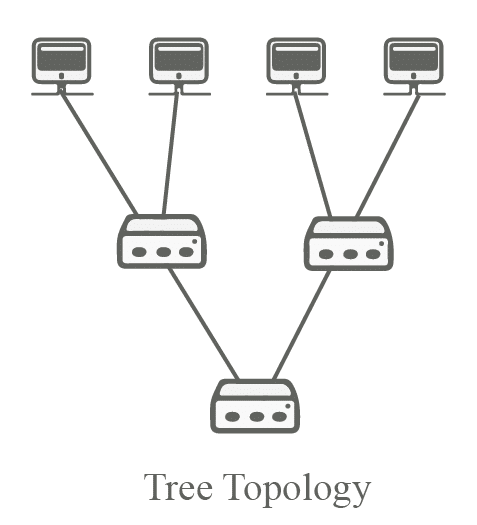
Pros and Cons?
- Pros. Tree topologies are highly flexible and scalable. As long as the core node (tree root) is robust, the whole network’s management, security, and performance are also robust. In addition, if a node or cable (from a branch), fails the entire network would continue to work.
- Cons. The centralization introduces the single-point-of-failure problem. If the central node has errors or is slow, the whole network goes down or fails. Adding more robust core and distribution switches can become expensive.
Note: To deal with the tree’s single-point-of-failure, network designers have to create active/standby (or load-balancing) implementations, which end up being costly. The redundant tree topology starts to resemble the full mesh topology.
Network Topology Design and Mappin
Which topology is best for your network?
Before choosing one network topology over the other, first, consider the requirements of your business. For example, do you value speed and redundancy? or prefer a cost-efficient and simple implementation?
Consider that network quality like speed, security, performance, reliability, and redundancy varies from topology to topology. Always consider your available resources; How much are you willing to spend on hardware and cabling? Or in expertise?
Determining your right fit
To determine the optimal network topology for you, find the balance between costs, performance, reliability, and the scalability levels you wish to expect.
- Dimensioning installation and operation costs. Topologies such as bus and star are generally cost-efficient because they don’t need considerable lengths of cable or numbers of servers. On the other hand, topologies like hybrid or mesh would require larger quantities of (and more powerful) cabling and servers. The same goes for installation, one type of topology is more accessible to implement than the other. In addition, consider the media type, such as coaxial cable, fiber, Ethernet, or wireless.
- Dimensioning performance and security. Cheaper topologies do not provide the level of performance that more expensive topologies can offer. For instance, speed might be strong performance quality that can determine one topology over the other. Security is another factor. For example, topologies like bus or ring tend to be much less secure than mesh topology.
- Consider availability and redundancy. Single-points-of-failures are considered flaws in network design. They put potential risk and vulnerability to any system because if a single node or line fails, the entire network fails. Centralized topologies like star, bus, or tree have a single-point-of-failure. Decentralized topologies like the double ring, mesh, or hybrid, have more points of failure, thus higher availability and redundancy.
- Think about scalability. If you forecast growth on your network, you might have to invest in the right network topology. With proper design, networks that need to handle sudden spikes or drops in data volumes can scale effortlessly. For instance, rings have poor scalability, while mesh has excellent scalability.
How to map your network topology
Although humans implement the network topology and structure, network mapping is best suited for software. There is some software capable of scanning and creating network topology diagrams. Such diagrams are vital for any network manager because they visually represent the physical and logical topologies. This allows managers to have better visibility over the nodes and the connections and do more efficient troubleshooting.
The SolarWinds Network Topology Mapper – FREE TRIAL
The SolarWinds Network Topology Mapper (NTM) is a network mapper tool designed to plot networks automatically. The tool shows the current network nodes and connections between them and specifies and updates their status. Furthermore, it displays such information in interrelated and scalable maps.
Key Features:
- Auto-discover and mapping.
- Multi-level network discovery.
- Creates multiple maps from a single scan.
- Perform multi-level network topology discovery.
- Scan network topology and detect changes.
- Export network diagrams.
- Manage the mandatory PCI compliance.
Pros:
- Uses autodiscover for automated mapping, great for larger more complex networks
- Uses multiple protocols to identify network devices, ICMP, SNMP, WMI, and CDP
- Designed to work in virtual environments and supports both VMWare and Hyper-V hosting
- Can build static maps and include devices from your network for capacity planning and testing
Cons:
- Would like to see a longer trial period
Download a fully functional 14-day free trial.
Site24x7 – FREE TRIAL
Site24x7 excels in network topology software with its real-time visualization, customizable views, and seamless integration for network performance monitoring. It serves as a robust solution, particularly for modern IT infrastructures requiring detailed, dynamic mapping of network layouts. The tool's alert system enhances its utility by promptly notifying administrators of any changes or issues, making it ideal for organizations seeking intuitive, comprehensive management and troubleshooting of their network structures.
Key Features
- Automated discovery and dynamic mapping of network topology
- Real-time visualization of network structure, including routers, switches, and other devices
- Customizable views and maps for different network segments
- Integration with network performance monitoring for a comprehensive overview
- Alerts and notifications for changes or issues within the network topology
Why do we recommend it?
Site24x7 is recommended for its advanced network topology mapping capabilities, which are essential for effectively managing and monitoring complex network structures. Its automated discovery and real-time visualization tools provide a clear and detailed view of network layouts, simplifying management tasks.
Who is it recommended for?
This tool is ideally suited for network administrators and IT professionals in medium to large organizations who need to maintain an accurate and up-to-date understanding of their network's structure. Its capabilities are particularly valuable in complex environments where network topology can be intricate and dynamic.
Pros:
- Automated and dynamic network topology mapping
- Real-time visualization of network layouts
- Integration with network performance monitoring for comprehensive insights
Cons:
- May offer more complexity than needed for smaller or simpler network environments
Final Words
In this post, we went through the core concept of network topology. We learned the connection types, from point-to-point, point-to-multi-point, to multi-drops. We also saw their classifications. We know that they can be centralized, decentralized, or distributed. One, having disadvantages and advantages over the other.
We went into detail on every network topology, from the Linear “Daisy Chain”, Ring, Bus, Mesh, Hybrid to the Tree topology. We also learn how to determine the correct topology for you, its design and map them using specialty software.
Network Topology FAQs
What is a network topology?
A network topology refers to the physical or logical arrangement of network devices, nodes, and links.
What are the different types of network topology?
There are several types of network topology, including bus, ring, star, mesh, tree, hybrid, and point-to-point.
What is a bus topology?
A bus topology is a network topology in which all devices are connected to a single cable, with the data transmitted in both directions.
What is a ring topology?
A ring topology is a network topology in which devices are connected in a circular fashion, with data transmitted in one direction.
What is a star topology?
A star topology is a network topology in which all devices are connected to a central hub or switch.
What is a mesh topology?
A mesh topology is a network topology in which devices are connected to multiple other devices in a non-linear fashion.
What is a tree topology?
A tree topology is a network topology in which devices are arranged in a hierarchical tree structure.
What is a hybrid topology?
A hybrid topology is a network topology that combines two or more different types of topologies.
What is a point-to-point topology?
A point-to-point topology is a network topology in which devices are connected directly to each other, without the use of a central hub or switch.
What are the factors to consider when choosing a network topology?
The factors to consider when choosing a network topology include scalability, reliability, cost, speed, and security.
What is network redundancy?
Network redundancy refers to the use of multiple devices, paths, or links in a network to ensure that there is no single point of failure.
What is a backbone network?
A backbone network is a high-speed network that connects multiple smaller networks or segments together.
What is network segmentation?
Network segmentation is the process of dividing a network into smaller, more manageable segments to improve security, performance, and scalability.
